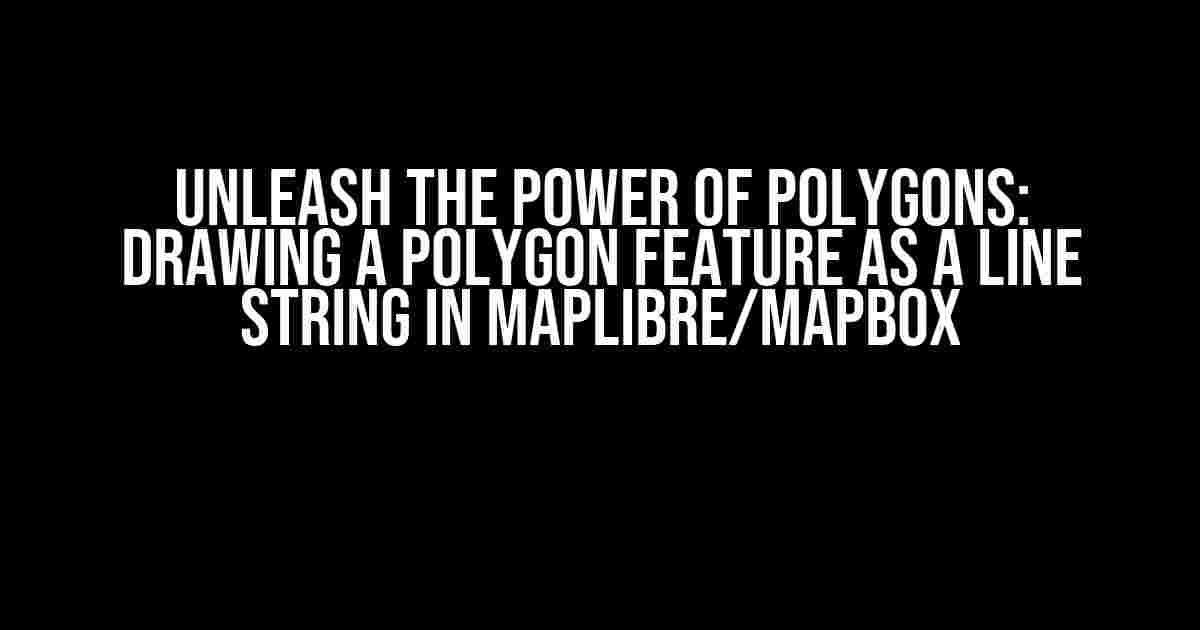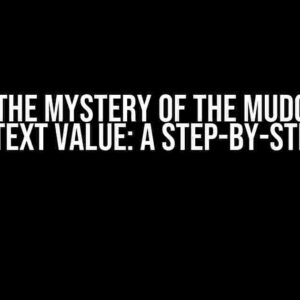If you’re a map enthusiast, you know how crucial it is to visualize complex spatial data in a way that’s both accurate and visually stunning. One of the most powerful features in MapLibre/Mapbox is the ability to draw POLYGON features as line strings. In this epic guide, we’ll take you on a journey to master this skill, empowering you to create bespoke maps that leave a lasting impression.
What is a POLYGON Feature, Anyway?
In the world of geospatial data, a POLYGON is a type of feature that represents a 2D shape with at least three vertices. Think of it as a fancy way of saying “complex shape.” Polygons can be used to represent anything from country borders to building footprints, and even lakes and rivers. When you draw a POLYGON feature as a line string, you’re essentially creating a sequence of points that form the boundary of the shape.
Why Draw POLYGONS as Line Strings?
- Efficient Data Storage: Representing polygons as line strings reduces the amount of data required to store and transmit the feature.
- Faster Rendering: Line strings are lighter on the map’s rendering engine, resulting in faster performance and smoother user experiences.
- Improved Visualization: By drawing polygons as line strings, you can create more detailed and realistic representations of complex shapes, making your maps more engaging and informative.
Getting Started with MapLibre/Mapbox
Before diving into the world of POLYGON features, make sure you have a basic understanding of MapLibre/Mapbox. If you’re new to the platform, start by creating a new map and familiarizing yourself with the interface.
Step 1: Create a New Map
Head over to the MapLibre/Mapbox website and create a new map. Choose a base map that suits your needs, and give your map a name and description.
Step 2: Add a New Layer
Click on the “Layers” tab and add a new layer. Choose the “Polygon” layer type, and select the “Line” renderer.
// Sample code for adding a new layer
var layer = {
"id": "polygon-layer",
"type": "line",
"source": {
"type": "geojson",
"data": {
"type": "FeatureCollection",
"features": []
}
},
"layout": {
"line-join": "round",
"line-cap": "round"
},
"paint": {
"line-color": "rgba(255, 0, 0, 0.8)",
"line-width": 2
}
};
map.addLayer(layer);
Creating a POLYGON Feature as a Line String
Now that you have a new layer set up, it’s time to create your POLYGON feature as a line string. You’ll need to define the coordinates of the polygon’s vertices in a GeoJSON format.
Step 1: Define the POLYGON Coordinates
Create an array of coordinates that represent the vertices of your polygon. In this example, we’ll create a simple polygon with four vertices.
var polygonCoords = [ [-122.084051, 37.385348], [-122.084213, 37.385564], [-122.083947, 37.385823], [-122.083811, 37.385641], [-122.084051, 37.385348] ];
Step 2: Create the GeoJSON Feature
Using the coordinates, create a GeoJSON feature that represents the POLYGON. Make sure to set the “type” property to “Polygon” and the “coordinates” property to the array of vertices.
var polygonFeature = {
"type": "Feature",
"geometry": {
"type": "Polygon",
"coordinates": [polygonCoords]
},
"properties": {}
};
Step 3: Add the Feature to the Layer
Add the GeoJSON feature to the layer’s “features” array. You can do this by using the `addFeature()` method or by directly modifying the layer’s data.
// Add the feature to the layer layer.source.data.features.push(polygonFeature); // Alternatively, use the addFeature() method map.addFeature(layer, polygonFeature);
Rending the POLYGON Feature as a Line String
By default, MapLibre/Mapbox will render the POLYGON feature as a filled shape. To render it as a line string, you need to adjust the layer’s “paint” properties.
Step 1: Update the Layer’s Paint Properties
Set the “line-color” and “line-width” properties to control the appearance of the line string.
layer.paint = {
"line-color": "rgba(255, 0, 0, 0.8)",
"line-width": 2
};
Step 2: Update the Layer’s Layout Properties
Set the “line-join” and “line-cap” properties to control the appearance of the line joints and caps.
layer.layout = {
"line-join": "round",
"line-cap": "round"
};
Putting it all Together
Now that you’ve created the POLYGON feature as a line string and updated the layer’s properties, it’s time to render the map.
// Render the map map.render();
The Result
Voilà! You should now see a beautifully rendered POLYGON feature as a line string on your map.
| Before | After |
|---|---|
 |
 |
Tips and Variations
Want to take your POLYGON feature to the next level? Here are some advanced techniques to explore:
- Holes and Donuts: Use the “inner” property to create holes within the polygon or create donut-like shapes.
- Multi-Polygons: Create complex shapes by combining multiple polygons and rendering them as a single line string.
- Dynamic Styling: Use data-driven styling to change the appearance of the line string based on attributes like size, color, or opacity.
Conclusion
Mastering the art of drawing POLYGON features as line strings in MapLibre/Mapbox is a powerful skill that can elevate your maps from ordinary to extraordinary. With these step-by-step instructions and a dash of creativity, you’ll be well on your way to creating bespoke maps that wow your audience.
Remember, the key to success lies in understanding the basics of POLYGON features, GeoJSON, and MapLibre/Mapbox’s rendering engine. Experiment with different techniques, and don’t be afraid to push the boundaries of what’s possible.
Happy mapping, and see you in the next adventure!
Frequently Asked Question
Get ready to unlock the secrets of drawing a polygon feature as a line string in MapLibre/Mapbox!
What is a polygon feature in MapLibre/Mapbox?
A polygon feature in MapLibre/Mapbox is a geometric shape represented by a series of connected points, used to define an area or boundary on a map. Think of it as the outline of a park, a lake, or a country boundary!
Why would I want to draw a polygon feature as a line string?
Drawing a polygon feature as a line string allows you to create a more detailed and accurate representation of the area or boundary. It’s especially useful when you need todisplay fine-grained details, like the outline of buildings or the boundaries of small features on a map!
How do I draw a polygon feature as a line string in MapLibre/Mapbox?
To draw a polygon feature as a line string, you’ll need to create a GeoJSON object that defines the polygon’s coordinates. Then, use the `map.addLayer()` method to add the GeoJSON object to your map, and voilà! Your polygon feature will be displayed as a line string!
Can I customize the appearance of my polygon feature as a line string?
Absolutely! You can customize the appearance of your polygon feature as a line string by using MapLibre/Mapbox’s styling options. For example, you can change the line color, width, and opacity to suit your needs. Get creative and make it pop!
What are some common use cases for drawing polygon features as line strings?
Use cases include creating detailed maps for urban planning, visualizing property boundaries, and displaying weather patterns or climate zones. The possibilities are endless, so get creative and explore the possibilities!







